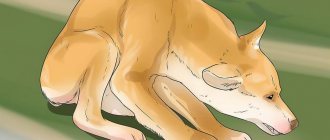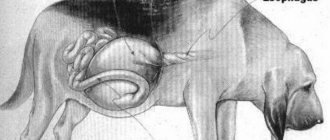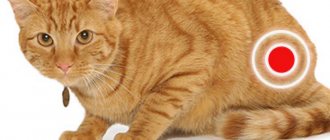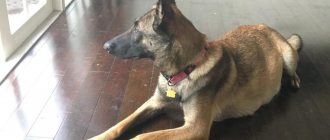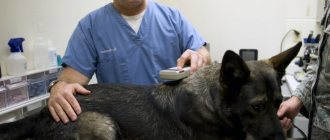The most common uroliths that form in dogs are:
• Tripelphosphates (magnesium ammonium phosphate)
• Calcium oxalate
• Uric acid salt
Less common uroliths include cystine, silica, calcium phosphate, and xanthine.
Most often found in dogs are Struvite or tripelphosphates. In most cases, these stones are formed due to an infection in the urinary system. Microflora is most often represented by Escherichia coli, Proteus, staphylococcus, Pseudomonas aeruginosa, etc. When urine is contaminated with bacteria, their accumulations adhere to the epithelium of the bladder and form microcolonies. During their life, microbes secrete the enzyme urease into the urine. Under the influence of the enzyme urease, the acidity of urine increases, which creates favorable conditions for struvite crystallization. Sterile struvite uroliths are very rare in dogs, but they have been found in the English Cocker Spaniel breed, which may indicate a genetic predisposition.
What does the appearance of oxalates in urine mean?
Salt deposits lead to the formation of stones and sand in the animal's bladder and kidneys.
The dog experiences pain when urinating, whines and behaves strangely, looks nervous or scared. If your pet's behavior has changed, this is a reason to be examined by a veterinarian. In the case of urolithiasis, you should not delay; the sooner you take action, the easier the treatment will be when the disease has not yet progressed. Further therapy depends on what type of stones have formed in the tissues of the kidneys or bladder. Causes of urolithiasis in dogs:
- Genetics. If one of the pet's parents suffered from the same disease, there is a high probability that he will have it too.
- Breed. Some breeds, due to their characteristics, have a congenital predisposition to urolithiasis. This often occurs in bulldogs, pugs, dachshunds, and hounds.
- Pathologies inside the body. Improper metabolism, dysfunction of the liver or kidneys will cause the disease. Sometimes urolithiasis provokes pathological changes in the animal’s vascular system.
- Infectious diseases. Urinary tract infections are dangerous.
- Floor. According to statistics, male dogs are more likely to suffer from urolithiasis.
A dog does not always get sick due to congenital characteristics or diseases. Improper living conditions for the animal lead to ICD:
Take the Attention Test! Find 10 differences! (click right here!)
Find the answer Are you bothered by some problem or question? Enter “Breed” or “Name of the problem” into the form, press Enter and you will find out everything about the issue that interests you.
- Ignoring the needs of the animal. If the dog is forced to wait a long time before going to the toilet, the urine begins to stagnate and crystallize. This is the process of formation of those same oxalates.
- Little activity. The dog must exercise a lot, otherwise the animal will become a victim of obesity. Excess weight leads to stagnation of fluids in the body and urine.
- Lack of water. Your pet should always have free access to water. It is important to monitor the quality of drinking; the water must be filtered and not contain harmful impurities.
- Poor nutrition. Just like people, animals need a balanced amount of protein, fat and carbohydrates and eat regularly. You cannot mix natural and dry food, overfeed your pet or keep it only on meat and cereals. Excess proteins and fats lead to urolithiasis.
Oxalates do not accumulate overnight, turning into sand and stones, it is a gradual process. When a dog is suffering from pain, the disease is already in an advanced state, it is important to be attentive to the health and behavior of the pet.
Signs of ICD:
- Frequent urination;
- Cloudy urine;
- Pinkish or even brown color of urine;
- The appearance of blood or pus;
- The dog began to lick the genitals more often than usual;
- Lethargic state;
- Poor appetite.
In a neglected state, the urinary tract becomes blocked, the dog begins to pee drop by drop, and there is too much blood in the urine. The animal loses a lot of weight, suffers from constant nausea and vomiting, convulsions may appear, and the body temperature rises. In such a critical condition, the dog may die. There is no need to wait for the full list of symptoms to appear. As soon as the urine becomes slightly cloudy, or the dog begins to ask to go to the toilet more often, this is a reason to consult a doctor.
What types of stones do dogs have?
Stones that become a problem for an animal can appear in any part of the urinary system: kidneys, urinary canals, bladder. And the cause of rocky formations is the products of certain substances that accumulate during the life of the dog. Then small pebbles, along with urine, pass along the walls of the canals and scratch the walls, thereby causing unbearable pain.
Large stones can clog blood vessels and urine, instead of coming out, will collect inside and poison the pet’s body. But this is not the main problem. When urine has nowhere to go, it will begin to rupture the walls of blood vessels and leak into the abdominal cavity.
In addition to stones, sand can accumulate in the urinary system, which is usually expelled, causing discomfort, but the dog’s condition remains satisfactory. Such sand usually appears when the pH value of urine acidity deviates from the norm and shifts to the acidic or alkaline side. Pebbles that accumulate in a pet’s body have the following types:
- Cystines are passed down through genes through some breeds. This type of stone is typical for dachshunds, bulldogs, and corgs. But this does not mean that other breeds cannot have such petrifications, they are just much less common.
- Oxalates are the most unpleasant type of stones. They grow very quickly, their shape and size can be anything. And this form of the disease is very difficult to treat.
- Phosphate stones also grow quickly, but are destroyed by following all the veterinarian's instructions.
- Struvite is the fossilized result of a number of diseases.
One dog can have several types of stones. Therefore, such procedures can be quite complex. Urolithiasis can be treated with folk remedies only in the early stages in order to remove sand from the body. Your best bet is to contact your veterinarian. Since this is a dangerous disease that can be fatal for your pet.
Treatment
The doctor takes the animal’s urine for examination. It must be fresh; if the liquid sits for a long time, crystals will form in it. This may give incorrect test results and misdiagnosis. A urine test can determine the presence of urolithiasis and the type of stones; the choice of treatment method depends on this. And to determine the size and location of oxalates, you will need to conduct an ultrasound or x-ray examination. This will help you understand where the stones are and how many there are, and check the general condition of the dog. A biochemical blood test may be required.
The veterinarian must carefully conduct all tests and collect a complete history, otherwise the probability of a positive treatment outcome is 50/50. The doctor must remove the stagnant urine from the dog’s body. Further treatment depends on the severity of the disease. Some animals require a diet, while others may require surgery. The dog is prescribed a course of medications and the urinary tract is cleaned.
If drug therapy fails to destroy or dissolve the stones, surgery will be required. Another indication for surgical intervention is blockage of the tract with a stone. In addition to directly removing oxalates, the surgeon must widen the urinary tract and, if necessary, create a new one. In critical cases, it is possible to completely remove the penis from a male dog.
Whatever treatment method is chosen, KSD cannot be cured completely. All doctors can do is put the disease into remission. The dog will have to follow a preventive diet for the rest of its life, and must be examined by a veterinarian at least once a year.
To prevent the disease from progressing, prevention is needed:
- Change the water every 2 days.
- When it's hot, take water with you when going for a walk.
- Walk the dog 3 times a day.
- Regular physical activity in the form of walking and light jogging.
- The animal must not be overloaded.
- Take a urine test every six months.
Preventing ICD will allow your dog to live a long and happy life.
Diagnostics
Only a specialist can diagnose the disease. The veterinarian conducts a comprehensive examination, studies test results, and collects anamnesis. Urolithiasis is clearly indicated when kidney or bladder epithelial cells and characteristic crystals are present in urine analysis. An X-ray or ultrasound result shows the presence of stones.
To clarify the medical history, the doctor must take a smear for microflora, conduct a urine culture, and do a biochemical and clinical blood test. Only after all the research is treatment prescribed.
Medicinal dog food
Food has been developed for dogs with urolithiasis. Their composition is selected to prevent the development of an alkaline environment in the body. A specialist may advise switching the dog completely to medicated food.
What brands are produced:
- Purina;
- Royal Canin;
- Hills;
- Eukanuba.
The first time after switching to feed, you will need to take a urine test every month. This is done to check the dynamics of changes. In the future, analyzes are carried out once a year, and this is enough.
Dissolution of struvite stones
Drugs are used to reduce the urine acidity level to less than 6.0, but more often individually selected dietary diets are used that promote the dissolution of struvite. In dogs consuming these diets, the amount of protein, phosphate and magnesium entering the body is reduced and the amount of sodium increases. As a result of consumption of this diet, the volume of urine excreted increases, the urine becomes unsaturated, and this is an unfavorable environment for crystallization. When taking specialized diets, no other food or treats are recommended, and access to drinking water should be available around the clock.
Diet
If a dog is diagnosed with urolithiasis, a diet is required. More often, doctors advise switching the animal to high-quality medicinal food. If you don’t want to change your pet’s food type, you need to create a balanced menu.
What to focus on:
- Cereals. This is buckwheat, barley grits, white refined rice, corn grits or pure corn.
- Legumes.
- Butter. It is useful to add at least a little to porridge.
- Boiled chicken eggs. You can give the whole thing or choose just the protein.
- Fish.
- Seafood.
- Poultry meat.
- Beef, beef liver.
- Mutton.
- Drink plenty of fluids.
In order to avoid relapse of the disease, everything salty and spicy, smoked meats, and lard should be excluded from the dog’s diet. You cannot feed your dog oatmeal in any form, red vegetables and fruits, carrots and cabbage, they contain a lot of alkalis. Apples and berries should also be excluded, or occasionally given to the dog as a treat.
Diet for oxalates, urates and cystines
Oxalates are urolithiasis that need to be removed only surgically. Afterwards, the dog must be prescribed a preventive diet, which reduces the risk of re-development of the disease by reducing the acidity of urine.
Cystines are formed when urine is acidified due to impaired cysteine metabolism in dogs. Urates are formed as a result of high levels of uric acid in urine.
For urolithiasis that occurs due to oxalates, cystines or urates, feed with an alkalizing effect is prescribed:
- Hill's Prescription Diet U/D Dog
Phosphorus, calcium and vitamin D are present in moderate doses, due to which the food reduces the risk of the formation of oxalate, urate and cystine deposits.
- Royal Canin Urinary U/C
Includes proteins with low levels of purine bases, which prevents the formation of urates. In combination with alkalizing properties, the food reduces the likelihood of developing urolithiasis of the urate type, and also prevents the formation of new stones. Low sodium and protein content prevents the formation of cystines. U/C feed is not used in the treatment of oxalate-type urolithiasis.
- Farmina Vet Life Dog Oxalate
Prescribed for oxalate, cystine and urate urolithiasis. It is often prescribed for kidney diseases. For urates and oxalates, the course of diet therapy is six months. Cystine deposits are eliminated with food throughout the year. In case of chronic kidney disease (chronic renal failure), nutritional therapy is prescribed for life.
- Royal Canin Urinary S/O
It is acceptable to prescribe for mixed type urolithiasis that has arisen against the background of struvite and oxalates.
Prepare before going to the vet
In the office, you may have to provide the veterinarian with all possible assistance (hold the animal while they take blood for analysis, give an injection, extinguish aggression, calm your voice, scratch its ears, stroke it). If you know that you are terrified of blood, IVs, or definitely cannot withstand the type of medical interventions, then perhaps you should ask a friend or relative for help.
Find a veterinary certificate, veterinary passport.
Take:
- Leash;
- Collar;
- Muzzle;
- Carrying;
- A pack of napkins;
- litter;
- Bowl, water (at the veterinarian's discretion)
Prepare answers to possible questions from the veterinarian:
- Are all vaccinations up to date on the animal?
- Pet’s behavior in recent days, appetite;
- His diet;
- What drugs and medicines did you give to the animal;
- Latest test data (if available).
It’s better to make an appointment in advance - you’ll save time and be able to calculate when you’ll have to take time off. This does not apply to life-threatening situations where you will have to take an animal to a veterinary clinic without an appointment.
Be affectionate with your pet, play, talk to him. You can take his favorite toy with you so that while you wait for your turn at the reception, you can distract your friend from the new environment.
Furry, feathered or scaly ones also need to be prepared. No matter how much you want to treat your little one with something tasty, remember: you need an empty stomach. Feeding is prohibited!
You can wash your animal without using detergents. But it is important not to touch your pet if there is nasal discharge, watery eyes, salivation (salivation), dandruff, scratching, rashes, skin scabs, loss of hair/feathers/scales, wounds and other external manifestations of a potential disease.
If the veterinarian has instructed, collect the animal’s urine in a sterile container, and pick up the feces with a stick (no blades of grass, specks, or debris). Transfer the feces into a sterile container. Send to the biochemical laboratory within 6 hours. The feces are examined for eggs of roundworms, pinworms, tapeworms, liver flukes, echinoccus, alvecoccus, pork tapeworm, bovine tapeworm, and gastrointestinal bleeding is detected.
At the veterinary hospital, the animal’s blood will be analyzed for antibodies to allergens, viruses, bacteria, and parasites.
Choosing a veterinary clinic
We determine the veterinary clinic where you plan to go. A big PR company doesn't promise quality. The price is explained by the huge amount of money invested in advertising and “signboarding” of the establishment.
It’s great if you can ask your friends about clinics where their pets were treated “humanely.” If you travel far from them, it may be worth sacrificing time for the health of your pet.
A few more tips on how to spot an unverified veterinary clinic:
- Refusal to provide certificates and licenses for veterinary activities.
- Strange and suspicious behavior of the veterinarian (inconsistency, flattery, attempts to intimidate, shouting).
- Prices are too low (compared to other organizations).
- Refusal to freely visit the veterinary clinic.
“We have a sanitary day”
Beware of scammers!
When you contact the veterinary clinic, you are informed: “we cannot accept you at this address, sanitary day/repair/inspection.” How much intelligence does a dispatcher have? The client is persuaded to have a veterinarian come to his home. The price does not change.
A veterinary clinic can exist purely nominally. And the invited “Aibolit” will not bear responsibility. There is a high probability of running into a person without a veterinary diploma or simply an unprofessional.
It is better to find time to visit the veterinary clinic on your own. This is safer for the animal.
Games on feelings
In real veterinary clinics there will be elements of “divorce”.
Veterinarians say that this is often determined by the client’s wallet. The greater the opportunity to pay for services and the more the owner worries about his pet, the more likely the animal will be prescribed additional immunostimulants, dietary supplements, water-soluble and fat-soluble vitamins, and special food. There are cases when this is really necessary (pedigreed, show animals, weakened after a serious illness). But it will be good if you ask your veterinarian in detail about the need for each appointment. Find out in detail about the results of the examination and analysis of your pet’s condition. Be persistent. Do not give in to attempts to intimidate you, be consistent in your questions. Consult a specialist who does not work at this veterinary clinic. If it turns out that half of the prescriptions are prescribed to enrich the veterinarian’s pocket, and not for the health of the animal, feel free to leave. And do not forget to leave a negative review about the organization - other owners may also suffer.
How to find out the truth
Another possible way for veterinarians to make dishonest money is to conceal the diagnosis. Let's say a veterinarian discovers a malignant tumor in a cat. But if he says that the tumor is benign and treatable. A housewife who dotes on her pet will give money for already useless procedures, medications and surgical interventions.
The veterinarian may deliberately “downplay” the diagnosis in order to earn more money. If something doesn't add up, insist on clarification. There is no need to be intimidated by unfamiliar terms - take a short break and try to find information on the Internet.
You are free to leave (or threaten to do so) to another clinic at any time.
Make sure that the veterinary clinic is honest - get tested in an independent laboratory.
Justice
What to do if an animal was injured as a result of unprofessional actions of a veterinarian:
- Write an official complaint addressed to the head of the clinic.
- File a complaint with the city veterinary department.
- You can contact Rospotrebnadzor.
- Contact a lawyer for help
The Law “On the Protection of Consumer Rights” and Article 245 of the Criminal Code “Cruelty to Animals” are the grounds for considering claims regarding the work of veterinary clinics.
Symptoms of ICD
In 80% of cases, owners notice that something is wrong with their pet when signs of illness become obvious. Dog:
- pees often and in small portions;
- urine changes color, becomes cloudy, or turns pink. After urination, droplets of blood remain on the bitch's loop or the tip of the male's penis. Sometimes drops of urine can be seen on the ground;
- experiences pain when emptying the bladder (the pet whines, trembles, looks tense and scared, pees in a strange position). Males sit down and do not lift their paws. Girls sit down very often, but urine either does not flow out at all or very little of it.
When there is blockage (obstruction) of the ducts, the signs of urolithiasis in dogs are the same, but more pronounced. It is clearly painful for the pet to empty the bladder, the abdomen becomes tight and painful (the dog does not open the peritoneum), thirst appears against the background of poor appetite, and the temperature may rise. This is an emergency and should be contacted by a veterinarian immediately!
Early symptoms are difficult to notice: a slight decrease in the amount of urine, cloudy urine with a heavy odor, unpleasant sensations (stinging, nagging pain - dogs have a high pain threshold, but they cannot talk about discomfort). It seems to the owner that the pet suddenly falls ill, but in fact, sand and stones have been forming for a long time (often we are talking about years of chronic illness). Therefore, it is important to undergo a preventive examination once a year and donate blood and urine for tests - this way ICD will be detected at an early stage, which will allow the veterinarian to begin treatment before the disease seriously undermines the health of the genitourinary system.
Saving
What to do if funds are limited and your pet needs medical care:
- Some procedures can be carried out independently. Giving a drug injection to a cat or dog is not difficult. Dressing uncomplicated wounds is also sufficient. Ask your veterinarian to teach you.
- How to properly give a pill to an animal: hide it in a lump of tightly rolled minced meat. If the animal bites through the decoy, you can crush the tablet and dissolve it in water, milk, liquid porridge, or food.
- If an animal has been prescribed a course of vitamins or some other non-medicinal but expensive drugs, it may be worth finding analogues at a lower price.
- There are various benefit programs in which you can participate. This could be, for example, sterilization, castration, or vaccination of an animal.
The need for surgery for urolithiasis in dogs
If your veterinarian recommends surgery, you should agree. Dogs tolerate anesthesia well, and the operation itself is simple and done frequently.
For example, silicates cannot be dissolved with medication. Therefore, they are removed surgically and then prevented from appearing with a special diet. After the intervention, special care and gentle treatment are required until the stitches heal.
Compliance with the diet and preventive measures almost always guarantee the absence of relapses. This is especially important for young pets and breeding dogs, for whom the health of the genitourinary system is extremely important.
Important points
- Refusal to vaccinate. This is dangerous for the animal and all those who will come into contact with it (people). Vaccination is a scientifically proven method of preventing many infectious diseases. Get your animal vaccinated by a trusted veterinarian (or with his approval yourself). It is important to get vaccinated against rabies - this is a fatal disease induced by the Rabies lyssavirus virus, which cannot be cured, but can be prevented.
- Anesthesia - inhalation, intravenous, anesthesia - epidural, conduction. They are necessary so that the animal does not suffer, to prevent painful shock. The veterinarian’s “hands on” are important here - both overdose and weak anesthesia lead to serious consequences (shock, poisoning, death) for the animal.
- Sterility, antiseptic. If you see that the veterinarian does not follow the rules of antiseptics (reuses disposable syringes, diapers, bandages, does not treat hands with antiseptic after contact with the previous animal), the best choice would be to contact another veterinarian.
- Important medicines:
- Antibiotics - amoxicillin, tilozil, trimethoprim, sulfadiazine, lincomycin, marbofloxacin;
- Antipyretics - paracetamol, salicylic acid preparations, antipyrine, butadione, amidopyrine;
- Anti-inflammatory drugs - vedaprofen, choline salicylate cycloferon, aspirin;
- Anesthetics - novocaine, lidocaine, dicaine, trimecaine;
- Hemostatics - fibrinogen, thrombin, vikasol, phytomenadione, calcium chloride, etamsylate;
- Antiparasitic - praziquantel, aversectin, albendazole, ivermectin, fluralaner.
If you care what happens to your pet, you should not neglect appointments.
Don't let unverified veterinary clinics endanger your pet and profit from their owner's feelings! If you have time and desire, it is worth trying to achieve justice in case of violation of ethical or legal standards.
